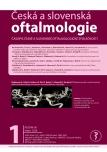Ultrasound Examination of the Orbit in Patients with Thyroid- Associated Orbitopathy – Examination Guide and Recommendations for Everyday Practice. A Review
Authors:
Marta Karhanová 1,2; Jakub Čivrný 3,4; Jana Kalitová 1; Jan Schovánek 5,6; Miroslava Malušková 1,2; Michal Hrevuš 1,2; Zuzana Schreiberová 1,2
Authors place of work:
Oční klinika, Fakultní nemocnice Olomouc
1; Oční klinika, Lékařská fakulta Univerzity Palackého Olomouc
2; Radiologická klinika, Fakultní nemocnice Olomouc
3; Radiologická klinika, Lékařská fakulta Univerzity Palackého Olomouc
4; III. interní klinika – nefrologická, revmatologická a endokrinologická, Fakultní nemocnice Olomouc
5; III. interní klinika – nefrologická, revmatologická a endokrinologická, Lékařská fakulta Univerzity Palackého Olomouc
6
Published in the journal:
Čes. a slov. Oftal., 80, 2024, No. 1, p. 3-11
Category:
doi:
https://doi.org/10.31348/2023/11
Summary
The purpose of this study is to present the possibilities and benefits of ultrasonography (US) of the orbit in the diagnosis and treatment of thyroid-associated orbitopathy (TAO).
Methods: US examination of the orbit is an essential addition to clinical and laboratory examination in TAO patients. Nevertheless, it is often neglected in clinical practice or indicated with delay. Based on previously published studies and our experience with the diagnosis and treatment of TAO patients, we aim to highlight the clear benefit of US examination of the orbit and oculomotor muscles, not only for correct TAO diagnosis but also in the monitoring of the disease over time. However, knowledge of the drawbacks and limitations of this method is also essential, as we shall point out. It is always necessary to remember that US examination must be evaluated in connection with the clinical findings.
A detailed recommendation for US examination of the extraocular muscles and the orbit based on our experiences with diagnosing and treating TAO patients in daily practice is also included.
Conclusion: According to our experience, US examination of the orbit is an excellent and irreplaceable tool for timely TAO diagnosis and further disease monitoring. However, considerable examiner experience and detailed knowledge of the clinical and ultrasound manifestations of TAO are essential.
Zdroje
1. Jiskra J, Gabalec F, Diblík P et al. Doporučený postup pro diagnostiku a léčbu endokrinní orbitopatie, NOVELIZACE 3/2022 n.d.
2. Česká oftalmologická společnost ČLS JEP. Doporučený postup pro diagnostiku a léčbu endokrinní orbitopatie [internet]. Available from: www.oftalmologie.com/cs/doporucene-postupy/doporuceny-postup-pro-diagnostiku-a-lecbu-endokrinni-orbitopatie.html Czech. n.d.
3. Baráková D. Echografie v oftalmologii. Kamil Mařík – Professional Publishing 2001, p.152.
4. Byrne SF, Green RL. Ultrasound of the eye and the orbit. St. Louis, Missouri, Mosby 2002, p.505
5. Fledelius, C., Zimmermann-Bielsing, T., Feldt-Rasmussen, U. Ultrasonically measured horizontal eye muscle thickness in thyroid associated orbitopathy: cross-sectional and longitudinal aspects in a Danish series. Acta Oftalmol Scand. 2003;81 : 143-150.
6. Vlainich AR, Romaldini JH, Pedro AB et al. Ultrasonography compared to magnetic resonance imaging in thyroid-associated Graves’ ophthalmopathy. Arq Bras Endocrinol Metabol. 2011;55(3):184-188.
7. Lennerstrand G, Tiam S, Isberg B et al. Magnetic resonance imaging and ultrasound measurements of extraocular muscles in thyroid-associated ophthalmopathy at different stages of the disease. Acta Ophthalmol Scand. 2007;85 : 192-201.
8. Nagy EV, Toth J, Kaldi I et al. Graves’ ophthalmopathy: eye muscle involvement in patients with diplopia. Eur J Endocrinol. 2000;142(6):591-597.
9. Karhanova M, Kovar R, Frysak Z. et al. Correlation between magnetic resonance imaging and ultrasound measurement of eye muscle thickness in thyroid-associated orbitopathy. Biomedical Papers. 2015;159(2):307-312.
10. Karhanová M, Kalitová J, Kovář R et al. Ocular hypertension in patients with active thyroid-associated orbitopathy: a predictor of disease severity, particularly of extraocular muscle enlargement. Graefes Arch Clin Exp Ophthalmol. 2022 Jul 14. doi: 10.1007/s00417-022-05760-0. Epub ahead of print
11. Alp MA, Ozgen A, Can I et al. Colour Doppler imaging of the orbital vasculature in Graves’ disease with computed tomographic correlation. Br J Ophthalmol. 2000;84(9):1027-1030.
12. Monteiro ML, Moritz RB, Angotti Neto H et al. Color Doppler imaging of the superior ophthalmic vein in patients with Graves’ orbitopathy before and after treatment of congestive disease. Clinics (Sao Paulo). 2011;66(8):1329-1334.
13. Walasik-Szemplińska D, Pauk-Domańska M, Sanocka U, Sudoł-Szopińska I. Doppler imaging of orbital vessels in the assessment of the activity and severity of thyroid-associated orbitopathy. J Ultrason. 2015;15(63):388-397.
14. Yuksel N, Unal O, Mutlu M, Ergeldi G, Caglayan M. Real-time ultrasound elastographic evaluation of extraocular muscle involvement in Graves‘ ophthalmopathy. Orbit. 2020;39(3):160-164.
Štítky
OftalmológiaČlánok vyšiel v časopise
Česká a slovenská oftalmologie

2024 Číslo 1
- Myasthenia gravis: kombinace chirurgie a farmakoterapie jako nejefektivnější modalita?
- Cyklosporin A v léčbě suchého oka − systematický přehled a metaanalýza
- Konzervační látka polyquaternium-1 zvyšuje cytotoxicitu a zánět spojený s NF-kappaB u epitelových buněk lidské rohovky
- Účinnost a bezpečnost 0,1% kationtové emulze cyklosporinu A v léčbě těžkého syndromu suchého oka − multicentrická randomizovaná studie
- Pomocné látky v roztoku latanoprostu bez konzervačních látek vyvolávají zánětlivou odpověď a cytotoxicitu u imortalizovaných lidských HCE-2 epitelových buněk rohovky
Najčítanejšie v tomto čísle
- Pars Plana Vitrectomy in the Treatment of Rhegmatogenous Retinal Detachment
- Improvement of Visual Field Defects after Neuroembolization Treatment of Intracranial Aneurysms. Case Reports
- Refractive Errors Among Members of the Armed Forces of the Czech Republic
- The Effect of Heterophoria on the Size of Distance and Near Fusion Vergence
